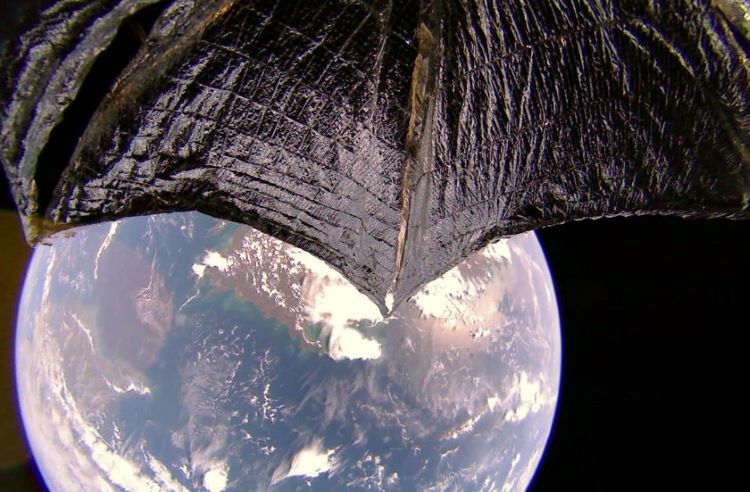A recent study submitted to *Acta Astronautica* explores the potential for using aerographite solar sails for traveling to Mars and interstellar space, which could dramatically reduce both the time and fuel required for such missions. This study comes while ongoing research into the use of solar sails is being conducted by a plethora of organizations along with the successful LightSail2 mission by The Planetary Society, and holds the potential to develop faster and more efficient propulsion systems for long-term space missions.
"Solar sail propulsion has the potential for rapid delivery of small payloads (sub-kilogram) throughout the solar system," Dr. René Heller, who is an astrophysicist at the Max Planck Institute for Solar System Research and a co-author on the study, tells *Universe Today*. "Compared to conventional chemical propulsion, which can bring hundreds of tons of payload to low-Earth orbit and deliver a large fraction of that to the Moon, Mars, and beyond, this sounds ridiculously small. But the key value of solar sail technology is speed."
Unlike conventional rockets, which rely on fuel in the form of a combustion of chemicals to exert an external force out the back of the spacecraft, solar sails don't require fuel. Instead, they use sunlight for their propulsion mechanism, as the giant sails catch solar photons much like wind sails catching the wind when traveling across water. The longer the solar sails are deployed, the more solar photons are captured, which gradually increases the speed of the spacecraft.
For the study, the researchers conducted simulations on how fast a solar sail made of aerographite with a mass up to 1 kilogram (2.2 pounds), including 720 grams of aerographite with a cross-sectional area of 104square meters, could reach Mars and the interstellar medium, also called the heliopause, using two trajectories from Earth known as direct outward transfer and inward transfer methods, respectively.
The direct outward transfer method for both the trip to Mars and the heliopause involved the solar sail both deploying and departing directly from a polar orbit around the Earth. The researchers determined that Mars being in opposition (directly opposite Earth from the Sun) at the time of solar sail deployment and departure from Earth would yield the best results for both velocity and travel time. This same polar orbit deployment and departure was also used for the heliopause trajectory, as well. For the inward transfer method, the solar sail would be delivered to approximately 0.6 astronomical units (AU) from the Sun via traditional chemical rockets, where the solar sail would deploy and begin its journey to either Mars or the heliopause. But how does an aerographite solar sail make this journey more feasible?
"With its low density of 0.18 kilograms per cubic meter, aerographite undercuts all conventional solar sail materials," Julius Karlapp, who is a Research Assistant at the Dresden University of Technology and lead author of the study, tells *Universe Today*. "Compared to Mylar (a metallized polyester foil), for example, the density is four orders of magnitude smaller. Assuming that the thrust developed by a solar sail is directly dependent on the mass of the sail, the resulting thrust force is much higher. In addition to the acceleration advantage, the mechanical properties of aerographite are amazing."
Through these simulations, the researchers found the direct outward transfer method and inward transfer method resulted in the solar sail reaching Mars in 26 days and 126 days, respectively, with the first 103 days being the travel time from Earth to the deployment point at 0.6 AU. For the journey to the heliopause, both methods resulted in 5.3 years and 4.2 years, respectively, with the first 103 days of the inward transfer method also being devoted to the travel time from the Earth to the deployment point at 0.6 AU, as well. The reason the heliopause is reached in a faster time with the inward transfer method is due to the solar sail achieving maximum speed at 300 days, as opposed to achieving maximum speed with the outward transfer method at approximately 2 years.
Current travel times to Mars range between 7-9 months, which only happens during specified launch windows every two years while relying on the positions of both planets to be aligned at both launch and arrival of any spacecraft going to, or coming from, Mars. Estimating current travel times to the heliopause can be done using NASA's Voyager 1 and Voyager 2 probes, which reached the heliopause at approximately 35 years and 41 years, respectively.
The researchers note that one major question of using solar sails is deceleration, or slowing down, upon arriving at the destination, specifically Mars, and while they mention aerocapture as one solution, they admit this still requires further study.
"Aerocapture maneuvers for hyperbolic trajectories (like flying from Earth to Mars) use the atmosphere to gradually reduce velocity due to drag," Dr. Martin Tajmar, who is a physicist and Professor of Space System at the Dresden University of Technology and a co-author on the study, tells *Universe Today*. "Therefore, less fuel is required to enter the Martian orbit. We use this braking maneuver to eliminate the need for additional braking thrusters, which in turn reduces the mass of the spacecraft. We're currently researching what alternative strategies might work for us. Yet the braking method is only one of many different challenges we are currently facing."
While solar sail technology has been proposed by NASA as far back as the 1970s, a recent example of solar sail technology is the NASA Solar Cruiser, which is currently scheduled to launch in February 2025.
What new discoveries will researchers make about solar sail technology in the coming years and decades? Only time will tell, and this is why we science!
As always, keep doing science & keep looking up!
 Universe Today
Universe Today

